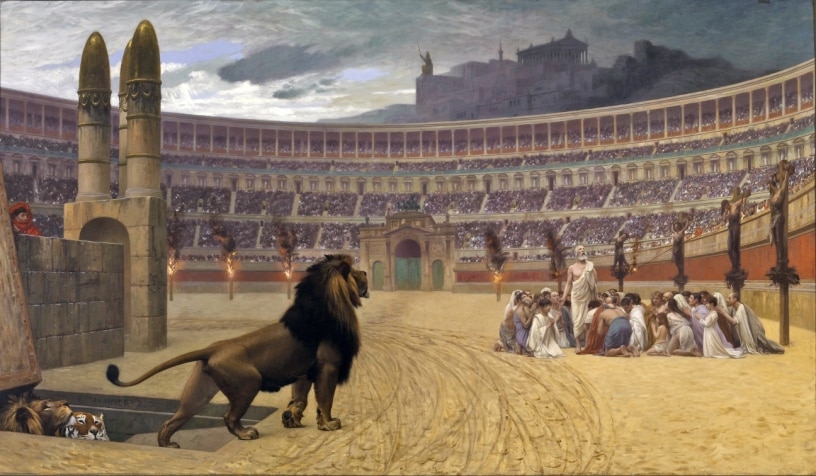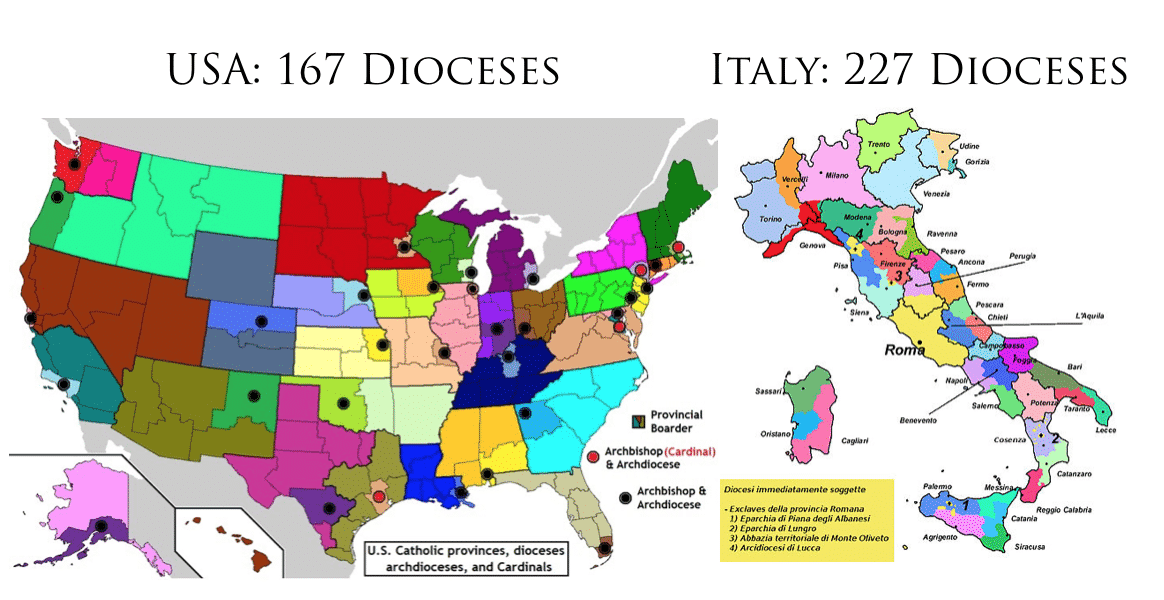Does the Mega-Diocese foster sexual scandals and bad priests? Yes
The 2002 Boston Scandal, the Cardinal McCarrick Scandal, and the Pennsylvania Grand Jury Report reveals that the bishops are at ground zero in this scandal.
- Some bishops didn’t properly vet seminarians and admit perverts.
- Some bishops ordained mental disturbed, predatory priests.
- Some bishops covered the crimes of Judas priests.
- Some bishops relocated the predatory Judas priests.
- Some bishops made secret payouts to victims to keep them quiet.
- Some bishops have been molesting and having homo-relations with seminarians and priests.
The laity are shocked that so-called Episcopoi (Greek word for “bishop” meaning “supervisor” or “overseer”) could do such horrible things and still show up smiling for photos after the post-confirmation ceremonies. How could this be?
Continue reading the article below or watch the video Youtube version here:
Three Reasons for Sexual Scandals:
- Denial of Christian Faith. These clerics are secretly atheists, agnostics, or Satanists who see the Church as a social justice network that pays well and provides a lifestyle of insurance, income, retirement and unquestioned access to compromised men and vulnerable children.
- Homosexuality. The 2004 John Jay Report publicized that 80% of priest abuse victims are male. The orientation of abuse was overwhelming homosexual According to James Martin and Larry Stammer, 15–58% of American Catholic priests are homosexual in orientation. Father Dariusz Oko of Poland has suggested that 50% of the bishops in the United States are homosexual.
- Evolution of the Mega-Diocese. Since 1900, the concept of the Catholic diocese has morphed into something that would not be recognized by Christians of the medieval period, and certainly not by the Church Fathers.
Today, I want to focus on the third. The problem of the Mega-Diocese: what it is, how it happened, and how it leads to clericalism and sexual abuse.
[callout]I am NOT stating that the Mega-Diocese is the root cause of sexual scandal or that eradicating it will fix everything! We need a a refocus on intrinsic evils, formation of true consciences, biblical literacy, removal of sexual active bishops/clergy, orthodox theological, Thomism, liturgical reverence, and heroic priests. But the Mega-Diocese is certainly infertile soil for these changes. Read on to discover the historic origin of this deformation and why it fosters abuse.[/callout]

Picture above: a bishop gathered with his diocese.
What is a Mega-Diocese?
A Mega-Diocese is a diocese so enormous that a bishop cannot oversee it. Remember “bishop” in Greek is επίσκοπος (episcopos) which means “overseer.” Epi means “over” as in the word epidermis. Skopos means “see” as in the English words scope and telescope.
[bctt tweet=”A Mega-Diocese is a diocese so enormous that a bishop cannot oversee it. ” username=”taylorrmarshall”]
We all desire lower Student/Teacher Ratios:
Parents eagerly search for schools with a low teacher/student ratio. Everyone in education knows that as you raise the teacher/student ratio, scores and academic performance go down. 12 students to 1 teacher proves to produce higher scores and better outcomes. 40 students to 1 teacher proves to produce lower scores and more drop outs.
But we currently have very high Disciple/Bishop Ratios:
What we have created over the last 150 years (since the loss of the Papal States, really) is an insanely high disciple/bishop ratio with regard to bishops. Bishops belong to the magisterium in union with the Pope. Magister is Latin for teacher. The bishop is the primary teacher. So we are discussing a student/teacher ratio here, as well. As the disciple/bishop ratio increases, what do we see? Lay people know their faith less (akin to lower scores), and they drop out at higher numbers (leave the church).
Currently here are the number of baptized in the top 4 USA archdioceses:
1 Los Angeles 4,174,304
2 New York 2,521,087
3 Chicago 2,442,000
4 Boston 2,077,487
How can a bishop manage this? He cannot. Not even Saint Paul could manage this? So how did we get here?
How did we get high Disciple/Bishop Ratios?
In the Patristic and Medieval Church, every wrinky-dink town had it’s own bishop. For evidence look at Italy:
- Italy has 227 dioceses. 116,350 sq mi and population of 60,483,973 people
- USA has 167 dioceses. 3,796,742 sq mi and population of 325,719,178 people
Here are 2 maps that I created for reference:

What we see here is that the Catholic Church from AD 100-1500 was appointing a bishop for almost every “town” in Italy since a bishop should be able to geographically access his flock.
[bctt tweet=”Italy has 227 dioceses. USA has 167 dioceses. This is wrong for the USA and it’s contrary to subsidiarity.” username=”taylorrmarshall”]
After 1520, but especially after 1870, the Catholic Church slowed down its bishop appointments, and the Papacy began to settle for “mega-dioceses.” By the 1900s, this problem was everywhere in the United States and has become ridiculous since the death of Pope John Paul II.
In 1950, the bishop of Los Angeles served 832,375 lay Catholics. In 2016, the archbishop of Los Angeles was responsible for 4,392,000 lay Catholics.
How the Mega-Diocese Fails Christians:
The Mega-Diocese is based on the presumption that one man can shepherd a million people and oversee hundreds of priests (both are impossible). The Archdiocese of Los Angeles has 1,117 priests and 4,392,000 baptized laity. One bishop can not oversee 1000+ priests. One bishop cannot be shepherd for 4.3 million people. For reference, the entire population of England in AD 1086 was 3.6 million. Imagine if all of England in AD 1086 had only one bishop! Ridiculous.
[bctt tweet=”The Mega-Diocese is based on the presumption that one man can shepherd a million people and oversee hundreds of priests (both are impossible). ” username=”taylorrmarshall”]
Enter the Legal Fiction of Auxiliary Bishops:
In order to “fix” this problem, the Popes began to appoint “Auxiliary Bishops.” According to Apostolic example, Patristic custom, and ancient Catholic Councils, a bishop must be a bishop of a geographic place. So you cannot have 3 bishops of the same geographic region. For Saint Ignatius of Antioch or Polycarp, multiple bishops in one place would be a schismatic and heretical act. There is only one geographic bishop for one geographic place.
So the Popes (initially Pope Leo X) created a legal fiction called Auxiliary Bishops with titular sees. The Pope appoints the Auxiliary Bishop to a geographical diocese that no longer exists, and then sends that auxiliary bishop to work inside the diocese of another bishop. Incidentally, the Pope that first allowed this legal fiction was the infamous Medici Pope Leo X (the same Pope whom Martin Luther spoke out against in 1517). Previous popes had banned the custom of auxiliary bishops with fictional titular sees.
For example, Bishop Robert Barron (to choose the most well-known auxiliary bishop) is an auxiliary bishop in Los Angeles. However, since every bishop must actually be a canonical bishop of his own geographical area, Bishop Barron is actually the titular bishop of “Macriana in Mauretania” – an ancient Berber town in Algeria.
On paper and in reality, this canonical appointment to Macriana in Mauretania is ridiculous. Bishop Barron has nothing to do with Macriana and we shouldn’t create the legal fiction of bishops over non-existing “sees.”
In the early Catholic Church, Bishop Barron would simply be bishop ordinary of his pastoral region of Santa Barbara. He would simply become Bishop of Santa Barbara – not Pretend Bishop of “Macriana in Mauretania” but really serving the people of Santa Barbara under the auspices of the geographical bishop of Los Angeles. What a mess.
I’m not blaming Bishop Barron or any auxiliary bishop for this situation. They are obeying the directives of canon law and the Pope and are in good faith with regard to their appointments. There are great men serving as auxiliary bishops throughout the world. But when we look at it from a systemic point of view, it reveals an ecclesiological problem that contradicts both the Council of Nicea and biblical and patristic theology about the local ecclesia.
How to fix the Mega-Diocese? Break it up with Subsidiarity
The Mega-Diocese is an offense against the Catholic doctrine of subsidiarity – the doctrine that matters ought to be handled by the smallest and most proximate competent authority – not by a Cardinal Archbishop living 90 miles away who also has the direct canonical care of souls for 1 million people. It’s a mistake to ask a bishop to be responsible for 1 million people and 1,000 priests. It’s a crime against the laity, too. The Mega-Diocese is bad for everyone.
[bctt tweet=”The Mega-Diocese is an offense against the Catholic doctrine of subsidiarity – the principle that matters ought to be handled by the smallest and most proximate competent authority – not by an archbishop living 90 miles away who has canonical care of souls for 1 million people.” username=”taylorrmarshall”]
When we see a public school teacher with 50 students in a class, we know its bad for the teacher and bad for the students. Everyone loses. Same the episcopal-diocesan structure.
How do we fix the Mega-Diocese problem? Obviously, a diocese of over one million souls is too big and too spread out. We need to follow the custom of ancient popes and have many, many, many more dioceses and bishops appointed. We need ecclesial subsidiarity. If Italy has 227 dioceses and the USA has 167 dioceses, we have an apparent problem. Creating more Mega-Dioceses and more and more auxiliary bishops will yield more abuse inside a broken system.
How big should a diocese be?
There were around 150-250,000 Catholics in the Archdiocese of Paris during the medieval era. It may seem extreme, but I don’t see the benefit of having a diocese any bigger than that. If a bishop had 100 priests and 100,000 people, it would be a manageable situation.
Still don’t believe me, ask Moses:
The biblical Mega-Diocese of Moses in Exodus 18 and the advice of Jethro:
Moses was exhausted overseeing the 400,000 Israelites under his pastoral supervision. His father-in-law Jethro observed this and rebuked Moses while providing a solution to break up his “Mega-Diocese”:
13 The next day Moses took his seat to serve as judge for the people, and they stood around him from morning till evening. 14 When his father-in-law (Jethro) saw all that Moses was doing for the people, he said, “What is this you are doing for the people? Why do you alone sit as judge, while all these people stand around you from morning till evening?”
15 Moses answered him, “Because the people come to me to seek God’s will. 16 Whenever they have a dispute, it is brought to me, and I decide between the parties and inform them of God’s decrees and instructions.”
17 Moses’ father-in-law replied, “What you are doing is not good. 18 You and these people who come to you will only wear yourselves out. The work is too heavy for you; you cannot handle it alone….21 But select capable men from all the people—men who fear God, trustworthy men who hate dishonest gain—and appoint them as officials over thousands, hundreds, fifties and tens. 22 Have them serve as judges for the people at all times, but have them bring every difficult case to you; the simple cases they can decide themselves. That will make your load lighter, because they will share it with you. 23 If you do this and God so commands, you will be able to stand the strain, and all these people will go home satisfied.”
If Moses couldn’t handle it, so also the modern bishop cannot handle it. Moses followed the advice of Jethro. He appointed men to oversee “thousands, hundreds, fifties and tens.” He didn’t place men “over 10,000 or even 100,000.” That’s too much! In other words, Jethro tells Moses: “Lets practice pastoral subsidiarity.”
[bctt tweet=”In other words, Jethro tells Moses: Lets practice pastoral subsidiarity.” username=”taylorrmarshall”]
It’s comical that my own enormous state of Texas has – 15 dioceses! The disciple/bishopratio here is horrible. Moreover, bishops spend entire weekends driving out into the country for confirmations at their parishes hours away.
Just like parents with kids in the school district, we lay people should beg and ask for a better disciple/bishop ratios. Say no to more auxiliary bishops. That’s a cheap bandaid covering the wound. The Archdioceses of LA and NYC should be broken into the 5 dioceses. The reason it won’t happen now is money. But in a pastorally sensitive church, those Mega-Dioceses would be prudently divided into 5 geographic dioceses. Let an auxiliary bishop simply be a bishop of that deanery and call him “bishop ordinary.”
[bctt tweet=”The Archdioceses of LA & NYC should be broken into the 5 dioceses. The reason it won’t happen now is money. But in a pastorally sensitive church, those Mega-Dioceses should be divided into 5 dioceses. Let an auxiliary bishop simply be a bishop ordinary of his deanery. ” username=”taylorrmarshall”]
Until we break up the Mega-Dioceses, do not expect clerical sexual scandal to get better or heal. The Mega-Diocese is unaccountable, noisy, not policed, and unsupervised. The Mega-Diocese allows the predatory priest (and bishop) to wear camouflage. Meanwhile a bishop close to his people and even closer to his priests as “father to fathers” is both more accountable and a better supervisor as episcopos.
I’d love to hear more recommendations, objections, and thoughts, especially from laity and clergy existing within the Mega-Diocese structures. One thing that I didn’t cover is that Mega-Diocese usually have low native seminarian counts and low ordination counts. They statistically cannot produce vocations. If the bishop is the sacramental “father of fathers,” then he is the overworked “absent father figure” within a Mega-Diocese. Vocations are not conceived by absent fathers.
[reminder]
Pray for the Church ad Jesum per Mariam cum Petro,
Dr Taylor Marshall
[bctt tweet=”If the bishop is the sacramental father of fathers, then he is the overworked absent father figure within a Mega-Diocese. Vocations are not conceived by absent fathers.” username=”taylorrmarshall”]
PS: I would also add that bishops should be chosen from among the local presbytery or at least from near regional dioceses, and not “imported” from elsewhere. Moreover, bishops should not be moved all over the nation like bishop pieces on a chess board. A bishop should stay the bishop of one place for life…like marriage. St John Fisher, pray for us.
What to Watch Next
SHOP THE TAYLOR MARSHALL STORE
Dive Deeper

GET CONFIDENT IN YOUR FAITH
Explore the fascinating world of Catholic teachings with Dr. Marshall. Together you’ll unpack the brilliant answers the Church gives to tough questions about the Faith. The best part: you go at your own pace. Start this exciting journey today.


 >
>



